Next: 6. Wellbore Stability Up: Introduction to Energy Geomechanics Previous: 4. Rock Yield and Failure Contents
Changes of stresses in the subsurface lead to deformation of geological structures. Deformations can be grouped in (1) gradual and continuous, such as folding that creates an anticline, and (2) abrupt and discontinuous, such as faults. The creation of fault discontinuities depends on loading strain rate and rock properties including rock brittleness. Faults are the result of brittle rock failure in shear at the large scale (Fig. 5.1).
Faults usually cut through several sedimentary strata (See outcrop fault examples in Fig. 5.2). Faults are important in energy geomechanics because they limit the magnitude of horizontal stresses, may constitute structural traps for fluid flow, favor reservoir compartmentalization, and other times create high permeability conduits for fluid flow. A map of faults and rock units in Texas is available here: https://txpub.usgs.gov/txgeology/.
Faults in subsurface formations are usually mapped through seismic reconstruction (see example in Fig. 5.3) and wellbore imaging.
Fig. 5.4-a shows the typical signature of fractures in a wellbore. An anomaly of electrical resistivity or ultrasonic P-wave velocity facilitates recognizing the fracture (dark pixels in the image). The reconstruction of this image (Fig. 5.4-b) helps measure fracture orientation (strike and dip - Fig. 5.4-c).
Comprehensive fracture mapping helps create 3D reservoir models that account for fault and fracture geomechanics (5.5). The magnitude of shear and normal stresses on faults and fractures depends on their orientation respect to the in-situ stress tensor.
Imagine any plane (such as the plane shown in Fig. 5.6) cutting horizontal sedimentary strata.
The strike is the line which results from the intersection of such plane and a horizontal plane.
The magnitude of the strike is the angle between the strike line and the north.
The angle of dip is the angle between a horizontal plane and the plane under consideration.
A layer is said to dip in a given direction when it gets deeper at the fastest rate into such direction.
One can think of the 
There are two conventions for reporting the magnitude of strike.
 . The quadrant convention is useful in the field. For example:
. The quadrant convention is useful in the field. For example:
 E” means 45
E” means 45 clockwise from the North towards the East
clockwise from the North towards the East
 W” means 45
W” means 45 clockwise from the South towards the West
clockwise from the South towards the West
 E” is the same as “S45
E” is the same as “S45 W” (Figure 5.7)
W” (Figure 5.7)
 measured from the North to the strike “vector” in clockwise direction (see Figure 5.24). The azimuth convention is most useful for data analytics and mathematical implementation. For example:
measured from the North to the strike “vector” in clockwise direction (see Figure 5.24). The azimuth convention is most useful for data analytics and mathematical implementation. For example:
 ” for a a fault strike N45
” for a a fault strike N45 E and dipping SE.
E and dipping SE.
 ” for a a fault strike N45
” for a a fault strike N45 E and dipping NW.
E and dipping NW.
![\includegraphics[scale=0.65]{.././Figures/split/6-StrikeConvention.PNG}](img659.svg) |
The dip is the angle between a horizontal plane and the line of maximum slope in the measured plane.
It is reported with angles between 0 and 90


Stereonets are very useful for plotting the orientation of many faults in a single 2D plot 5.8. The stereonet represents a fault plane by a dot, which is the intersection of a line normal to the fault plane and a lower hemisphere projection. Visit this website for an online animation of stereonets: https://app.visiblegeology.com/stereonetApp.html.
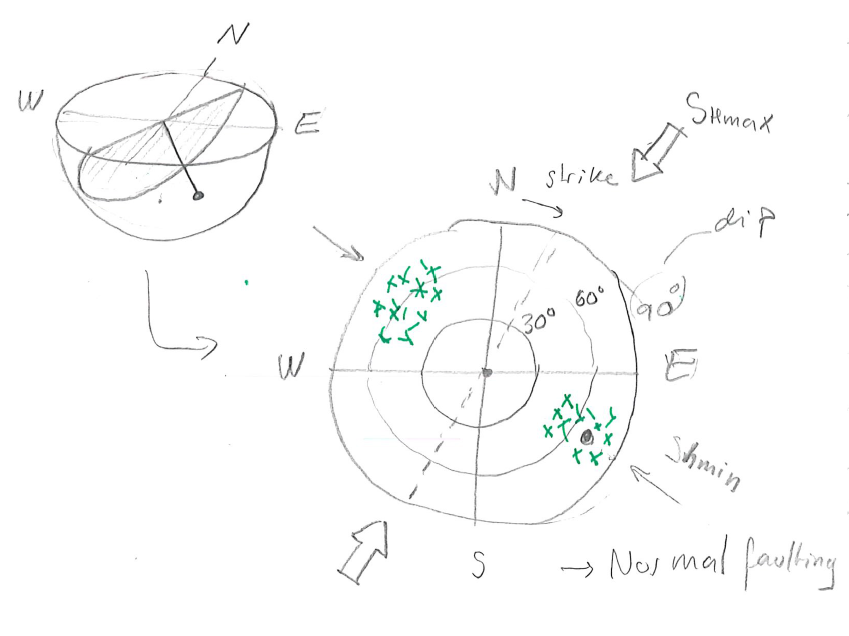 |
The geological map of a single formation, say a sandy layer formation, plots the top of such formation with depth in contour lines (Fig. 5.9b). Faults can also be represented in geological maps. Normal faults are represented as thick lines with thickness proportional to the heave of the fault (Fig. 5.9c). Reverse and thrust faults (negative heave) are plotted as lines with intermittent triangles on the dipping side (Fig. 5.9d). Fig. 5.10 shows an example application of this convention to the North Sea.
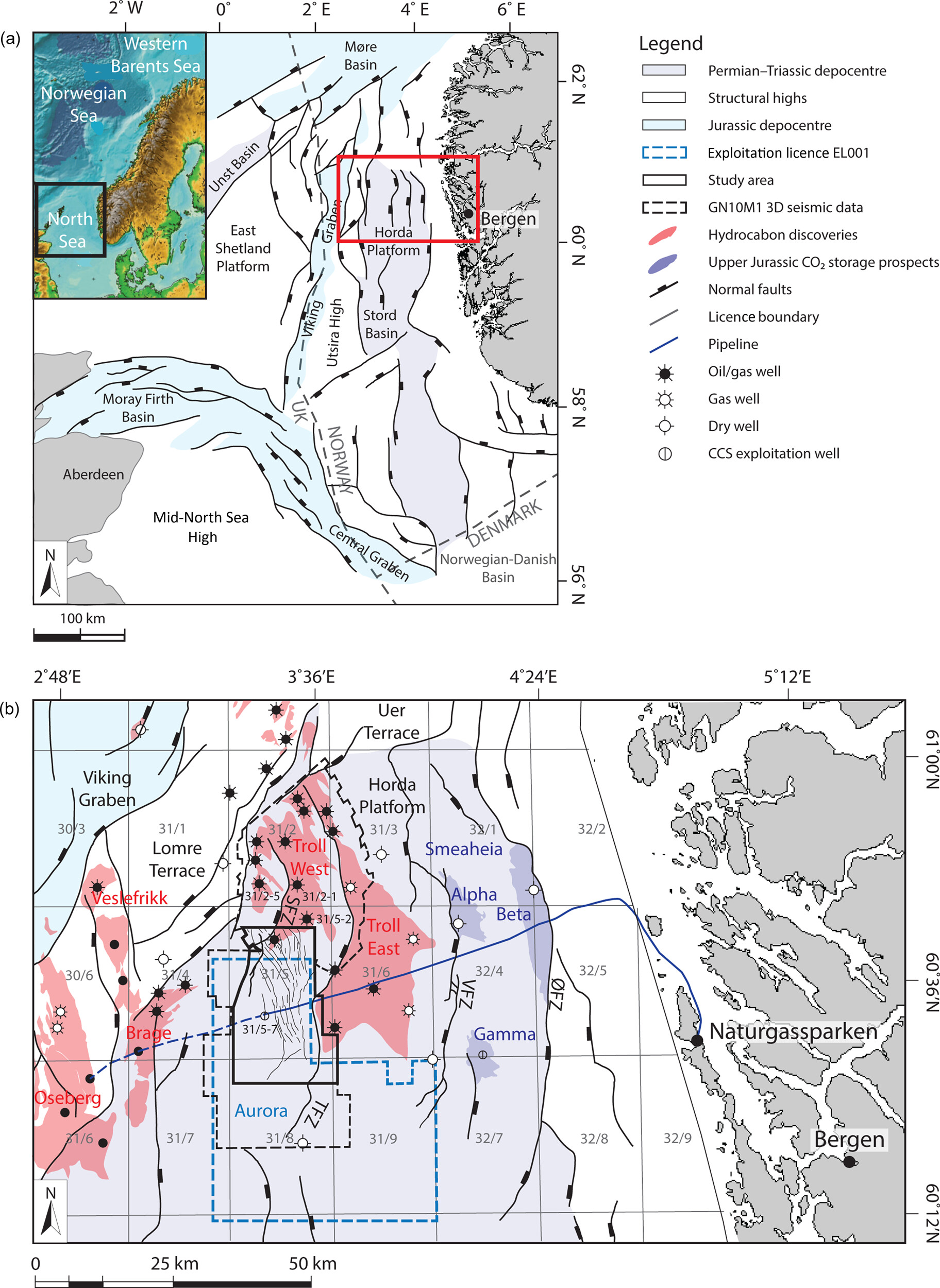 |
Strike and dip of sedimentary strata can be reported in geological maps as shown in Fig. 5.11.
At the large scale, the Earth's crust is constituted by “already broken" rock layers.
These discontinuities are comprised mostly of faults.
The cementation or cohesive strength of faults is negligible because the rock is already broken at those interfaces.
Hence, a large block of rock does not have any cohesive strength or “unconfined compression strength”.
As a result, its shear strength depends only on frictional strength according to the Coulomb frictional criterion (Fig. 5.12).
You may think of “El Capitán” rock cliff (https://www.reviewjournal.com/wp-content/uploads/2018/06/10646363_web1_yosemite-fatal-fall_6053325.jpg) as an example of a rock mass, strong and continuous, but that is an exception, not the rule.
Furthermore, the size of “El Capitán” (


Because of the lack of cohesive strength of the Earth's crust at the large scale, its shear strength just depends on frictional strength through the friction coefficient 



 |
(5.1) |
which can be rewritten in terms of principal stresses as
 |
(5.2) |
where
 |
(5.3) |
For typical friction coefficients the coefficient 

The maximum allowable stress anisotropy in a geological formation depends on its shear strength. Faults form or reactivate when this stress anisotropy, and therefore shear strength, is surpassed.
 implies fault slip.
implies fault slip.
 implies no fault slip.
implies no fault slip.
A normal fault is caused by in-situ stress conditions in which
 |
(5.4) |
 .
These stress conditions are typical of tectonically passive and laterally extensional environments.
For example, the Permian Basin in Texas is mostly under normal faulting stress regime.
The fault plane is a shear rupture plane. Its orientation is (
.
These stress conditions are typical of tectonically passive and laterally extensional environments.
For example, the Permian Basin in Texas is mostly under normal faulting stress regime.
The fault plane is a shear rupture plane. Its orientation is (
 ) in vertical direction from the horizontal plane (the plane perpendicular to
) in vertical direction from the horizontal plane (the plane perpendicular to  ) to the plane of
) to the plane of  .
The blocks move along the direction of
.
The blocks move along the direction of  and do work against
and do work against  .
At any point in the fault, the block above the fault is called the “hanging-wall” and the block below is the “footwall” (Fig. 5.13).
.
At any point in the fault, the block above the fault is called the “hanging-wall” and the block below is the “footwall” (Fig. 5.13).
Normal faults usually occur in pairs.
Notice that the shear failure angle includes two possible solutions (for

A thrust fault is caused by in-situ stress conditions in which
 |
(5.5) |
These stress conditions are typical of locations with high compressive tectonic strains.
For example, sedimentary basins close to the Andes and Himalayas foothills are under reverse faulting regime.
The fault plane is a shear rupture plane.
Its orientation is





A fault that may have been caused by paleo-stresses corresponding to a normal stress regime, but now moves according to in-situ stress conditions of a thrust fault stress environment is termed a reverse fault (Fig. 5.16).
A strike-slip fault is caused by in-situ stress conditions in which
 |
(5.6) |
These stress conditions are typical of high compressive tectonic strains mostly in one direction.
Some sedimentary basins around the Rocky Mountains and near California are under strike slip regime.
The fault plane is a shear rupture plane and it is vertical. Its orientation is



The type of fault that occurs for each stress combination gives rise to the name of the stress faulting regime (Table 5.2). Notice that stresses may change in magnitude and direction with time at a given location (see stress map in Fig. 5.18 - other maps available at http://www.world-stress-map.org/). Furthermore, the same location may evolve through different stress regimes over geological periods of time. The stress regime can also change with depth at the same location. Changes of stress regime with depth are critical for defining the geometry of fluid-driven fractures.
![\includegraphics[scale=0.65]{.././Figures/split/6-18.pdf}](img687.svg) |
The ideal orientation of a hydraulic fracture is a plane perpendicular to the minimum principal stress 



 and
and  ,
,
 ,
,
 from the plane perpendicular to
from the plane perpendicular to  towards the plane perpendicular to
towards the plane perpendicular to  .
.
![\includegraphics[scale=0.50]{.././Figures/split/6-IdealFaultOrientationGC.pdf}](img688.svg) |
Notice that all these angles vary according to the stress regime. Faults formed in NF stress regime tend to be steep. Faults formed in RF stress regime are not too steep. Faults formed in SS stress regime are vertical.
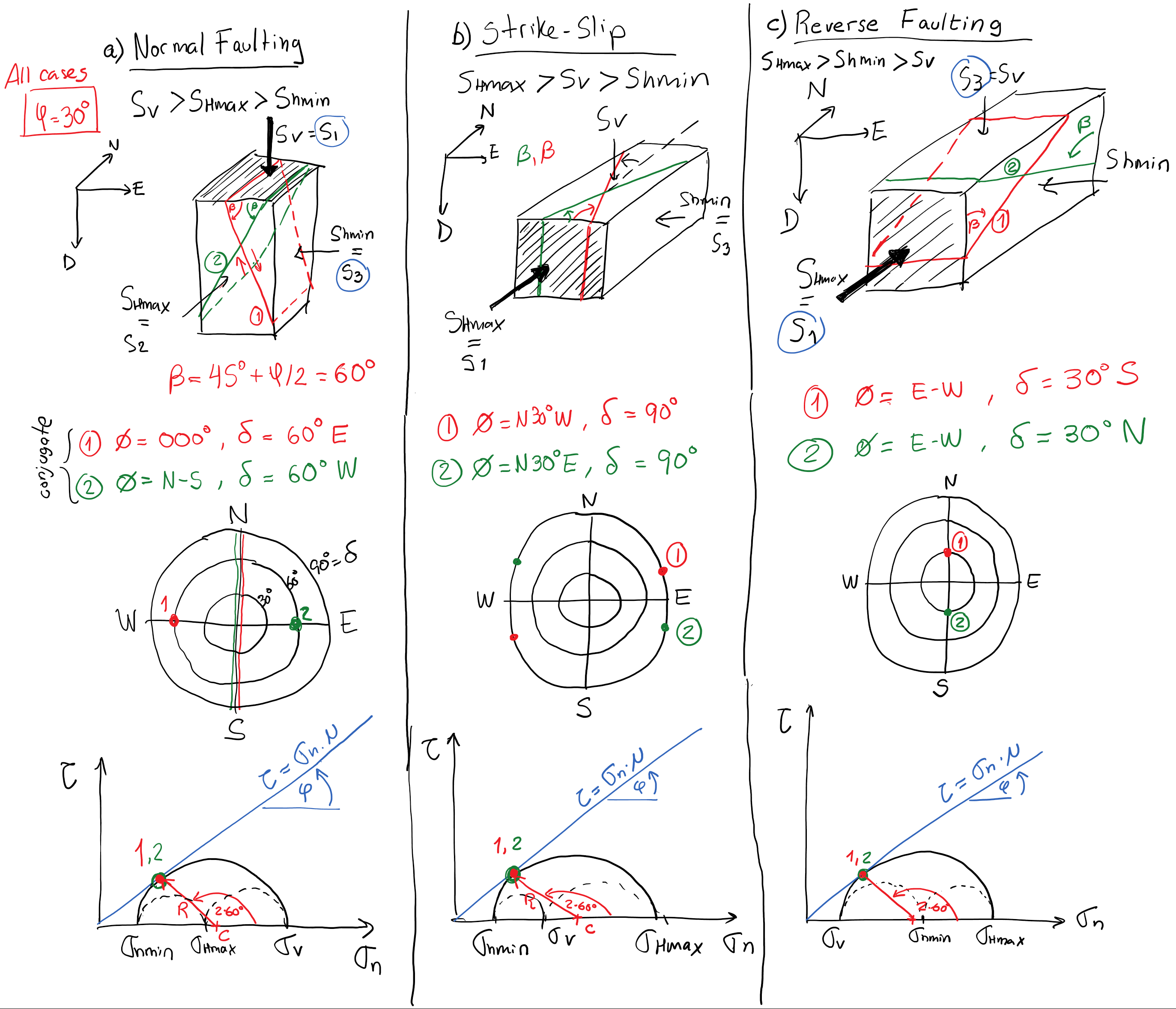 |
PROBLEM 5.1: Find the ideal orientation of a hydraulic fracture and faults (shear fractures) at a location subjected to the following state of stress and conditions:
 is a principal stress
is a principal stress
 is N60
is N60 W
W
 = 30
= 30 .
.
SOLUTION
First, recognize the planes of 





![\includegraphics[scale=0.75]{.././Figures/split/6-IdealFracP1.pdf}](img689.svg)
A hydraulic fracture would be perpendicular to 




The dip of faults depends on the friction angle. In this case, the failure angle is:

 going from the plane of
going from the plane of  to the plane of
to the plane of  .
Thus, the strike of the two possible faults is
.
Thus, the strike of the two possible faults is
 and the dips are
and the dips are
 SE and
SE and
 NW.
NW.

PROBLEM 5.2: Find the ideal orientation of a hydraulic fracture and faults (shear fractures) at a location subjected to the following state of stress and conditions:
 is a principal stress
is a principal stress
 is 010
is 010
 = 40
= 40 .
.
SOLUTION
First, recognize the planes of 





![\includegraphics[scale=0.75]{.././Figures/split/6-IdealFracP2.pdf}](img695.svg)
A hydraulic fracture would be perpendicular to 




The dip of faults depends on the friction angle. In this case, the failure angle is:

 going from the plane of
going from the plane of  to the plane of
to the plane of  .
Thus, the strikes of the two possible faults are
.
Thus, the strikes of the two possible faults are
 and
and
 , the dip is
, the dip is
 .
.

In this section we will review two methods to calculate normal and shear stresses on fractures and faults. The first part reviews the Mohr circle method in order to have a conceptual understanding of stress projection on faults and maximum ratio between shear stress and effective normal stress. The second part discusses the tensor method, which requires the definition of three coordinate systems and matrix multiplication. The tensor method can be easily implemented in a computer script but is laborious to work out manually.
The 3D Mohr circle is a graphical representation of the stress tensor and all its projections (or possibles values of normal effective stress 




Likewise, non-trivial solutions of stress projection at an arbitrary plane angle include all the points delimited by the three Mohr circles. Let's consider solutions along each circle in Fig. 5.21.
 ) represents the possible state of stresses that result as a combination of
) represents the possible state of stresses that result as a combination of  and
and
 . The shear stress
. The shear stress  and normal effective stress
and normal effective stress  of any plane in between the planes of
of any plane in between the planes of  and
and
 and colinear with
and colinear with
 can be found through the angle
can be found through the angle  measured from
measured from  .
.
 ) represents the possible state of stresses that result as a combination of
) represents the possible state of stresses that result as a combination of
 and
and
 . The shear stress
. The shear stress  and normal effective stress
and normal effective stress  of any plane in between the planes of
of any plane in between the planes of
 and
and
 and colinear with
and colinear with
 can be found through the angle
can be found through the angle  measured from
measured from

 ) represents the possible state of stresses that result as a combination of
) represents the possible state of stresses that result as a combination of
 and
and
 . The shear stress
. The shear stress  and normal effective stress
and normal effective stress  of any plane in between the planes of
of any plane in between the planes of
 and
and
 and colinear with
and colinear with
 can be found through the angle
can be found through the angle  measured from
measured from

For this example (normal faulting, 



PROBLEM 5.3: Find the shear and normal effective stresses on a fault plane within the following state of stress and conditions:
 , dip = 60
, dip = 60 .
.
 23 MPa (principal),
23 MPa (principal),
 20 MPa,
20 MPa,
 13.8 MPa (azimuth: 090
13.8 MPa (azimuth: 090 ), and
), and  10 MPa.
10 MPa.
SOLUTION
![\includegraphics[scale=0.65]{.././Figures/split/6-3DMohrCircleP1.pdf}](img709.svg)
 13 MPa,
13 MPa,
 10 MPa,
10 MPa,
 3.8 MPa.
Based on the Mohr circle of
3.8 MPa.
Based on the Mohr circle of  with
with
 and trigonometry:
and trigonometry:


PROBLEM 5.4: Find the shear and normal effective stresses on a fault plane within the following state of stress and conditions:
 E, dip: 90
E, dip: 90 .
.
 30 MPa (principal),
30 MPa (principal),
 45 MPa,
45 MPa,
 25 MPa (azimuth: N30
25 MPa (azimuth: N30 E), and
E), and  15 MPa.
15 MPa.
SOLUTION
![\includegraphics[scale=0.65]{.././Figures/split/6-3DMohrCircleP2.pdf}](img715.svg)
The effective stresses are:







This subsection describes the procedure to calculate stresses



The first step consists on defining the principal stress coordinate system and the geographical coordinate system (both right-handed coordinate systems).
 for
for  ,
,
 for
for  , and
, and
 for
for  (Fig. 5.22). The stress tensor is termed
(Fig. 5.22). The stress tensor is termed
 in this coordinate system.
in this coordinate system.
 pointing in North direction,
pointing in North direction,
 pointing in East direction, and
pointing in East direction, and
 pointing down in direction of increasing depth (Fig. 5.22). We will refer this basis as the “NED” basis. The stress tensor is termed
pointing down in direction of increasing depth (Fig. 5.22). We will refer this basis as the “NED” basis. The stress tensor is termed
 in this coordinate system.
in this coordinate system.
The second step involves constructing a change of basis matrix 






![\includegraphics[scale=0.65]{.././Figures/split/6-33.pdf}](img723.svg) |
| Normal faulting | Strike slip | Reverse faulting | |
 |
Azimuth of  |
Azimuth of  |
Azimuth of  |
 |
 |
 |
 |
 |
 |
 |
 |
Check out this link https://mybinder.org/v2/gh/johntfoster/rotation_widget/master?filepath=rotation_widget-rise.ipynb for an animation of 


With the matrix 


 |
(5.8) |
and therefore:
where the superscript 
PROBLEM 5.5: Calculate






SOLUTION
The principal stress tensor is
![\begin{displaymath}\uuline{S}{}_P
=
\left[
\begin{array}{ccc}
30 & 0 & 0 \\
0 & 25 & 0 \\
0 & 0 & 20
\end{array}\right]\end{displaymath}](img732.svg) |
Using Table 5.3 and considering that 



![\begin{displaymath}R_{PG}
=
\left[
\begin{array}{ccc}
0 & 0 & -1 \\
0 & 1 & 0 \\
1 & 0 & 0
\end{array}\right]\end{displaymath}](img736.svg) |
Finally, using equation 5.9
![\begin{displaymath}\uuline{S}{}_G
=
\left[
\begin{array}{ccc}
0 & 0 & -1 \\
0 &...
...0 & 25 & 0 \\
0 & 0 & 30
\end{array}\right]
\: \: \blacksquare\end{displaymath}](img737.svg) |
PROBLEM 5.6: Calculate






SOLUTION
The principal stress tensor is
![\begin{displaymath}\uuline{S}{}_P
=
\left[
\begin{array}{ccc}
30 & 0 & 0 \\
0 & 25 & 0 \\
0 & 0 & 20
\end{array}\right]\end{displaymath}](img732.svg) |
Using Table 5.3 and considering that





![\begin{displaymath}R_{PG}
=
\left[
\begin{array}{ccc}
1 & 0 & 0 \\
0 & 0 & 1 \\
0 & -1 & 0
\end{array}\right]\end{displaymath}](img740.svg) |
Finally, using equation 5.9
![\begin{displaymath}\uuline{S}{}_G
=
\left[
\begin{array}{ccc}
1 & 0 & 0 \\
0 & ...
...0 & 20 & 0 \\
0 & 0 & 25
\end{array}\right]
\: \: \blacksquare\end{displaymath}](img741.svg) |
PROBLEM 5.7: Calculate






SOLUTION
The principal stress tensor is
![\begin{displaymath}\uuline{S}{}_P
=
\left[
\begin{array}{ccc}
30 & 0 & 0 \\
0 & 25 & 0 \\
0 & 0 & 20
\end{array}\right]\end{displaymath}](img732.svg) |
Using Table 5.3 and considering that





![\begin{displaymath}R_{PG}
=
\left[
\begin{array}{ccc}
0 & 1 & 0 \\
-1 & 0 & 0 \\
0 & 0 & 1
\end{array}\right]\end{displaymath}](img743.svg) |
Finally, using equation 5.9
![\begin{displaymath}\uuline{S}{}_G
=
\left[
\begin{array}{ccc}
0 & 1 & 0 \\
-1 &...
...0 & 30 & 0 \\
0 & 0 & 20
\end{array}\right]
\: \: \blacksquare\end{displaymath}](img744.svg) |
PROBLEM 5.8: Calculate







SOLUTION
The principal stress tensor is
![\begin{displaymath}\uuline{S}{}_P
=
\left[
\begin{array}{ccc}
60 & 0 & 0 \\
0 & 40 & 0 \\
0 & 0 & 35
\end{array}\right]\end{displaymath}](img748.svg) |
Using Table 5.3 and considering that





![\begin{displaymath}R_{PG}
=
\left[
\begin{array}{ccc}
-0.707 & 0.707 & 0 \\
0 & 0 & 1 \\
0.707 & 0.707 & 0
\end{array}\right]\end{displaymath}](img750.svg) |
Finally, using equation 5.9
![\begin{displaymath}\uuline{S}{}_G
=
\left[
\begin{array}{ccc}
-0.707 & 0.707 & 0...
...& 47.5 & 0 \\
0 & 0 & 40
\end{array}\right]
\: \: \blacksquare\end{displaymath}](img751.svg) |
The third step consists in defining the fault plane coordinate system.
The coordinate system basis is comprised of 




The fourth step (and last) consists in projecting the stress tensor based on the geographical coordinate system onto the fault base vectors.
The stress vector acting on the plane of the fault is 




 |
(5.10) |
The total normal stress on the plane of the fault is 

 |
(5.11) |
The effective normal stress on the fault plane is



 |
(5.12) |
The dot product is used in all these vector to vector multiplications. The geometrical meaning is the projection of one vector onto the other.
The effective normal stress 

 |
(5.13) |
 |
(5.14) |
The 


 |
(5.15) |
PROBLEM 5.9: Calculate 












SOLUTION
The tensor of principal stresses is
![\begin{displaymath}\uuline{S}{}_P
=
\left[
\begin{array}{ccc}
23 & 0 & 0 \\
0 & 15 & 0 \\
0 & 0 & 13.8
\end{array}\right]\end{displaymath}](img777.svg) |
Using Table 5.3 and considering that 





![\begin{displaymath}R_{PG}
=
\left[
\begin{array}{ccc}
0 & 0 & -1 \\
-1 & 0 & 0 \\
0 & 1 & 0
\end{array}\right]\end{displaymath}](img778.svg) |
and the total stress in the geographical coordinate system results
![\begin{displaymath}\uuline{S}{}_G
=
\left[
\begin{array}{ccc}
15 & 0 & 0 \\
0 & 13.8 & 0 \\
0 & 0 & 23
\end{array}\right]\end{displaymath}](img779.svg) |
Given the orientation of the fault, the vector normal to the fault is
![\begin{displaymath}\uline{n}{}_n
=
\left[
\begin{array}{c}
0 \\
0.867 \\
-0.5
\end{array}\right]\end{displaymath}](img780.svg) |
Finally, the stresses on the fault are
![$\uline{t}= [0,11.95,-11.50]$](img781.svg)





PROBLEM 5.10: Calculate 












SOLUTION
The tensor of principal stresses is
![\begin{displaymath}\uuline{S}{}_P
=
\left[
\begin{array}{ccc}
45 & 0 & 0 \\
0 & 30 & 0 \\
0 & 0 & 25
\end{array}\right] \text{ MPa}\end{displaymath}](img789.svg) |
Using Table 5.3 and considering that 





![\begin{displaymath}R_{PG}
=
\left[
\begin{array}{ccc}
-0.5 & 0.866 & 0 \\
0 & 0 & 1 \\
0.866 & 0.5 & 0
\end{array}\right]\end{displaymath}](img791.svg) |
and the total stress in the geographical coordinate system results
![\begin{displaymath}\uuline{S}{}_G
=
\left[
\begin{array}{ccc}
30 & -8.66 & 0 \\
-8.66 & 40 & 0 \\
0 & 0 & 30
\end{array}\right] \text{ MPa}\end{displaymath}](img792.svg) |
Given the orientation of the fault, the vector normal to the fault is
![\begin{displaymath}\uline{n}{}_n
=
\left[
\begin{array}{c}
-0.866 \\
0.5 \\
0
\end{array}\right]\end{displaymath}](img793.svg) |
Finally, the stresses on the fault are
![$\uline{t}= [-30.31,27.5,0]$](img794.svg)





PROBLEM 5.11: Calculate 













SOLUTION
The tensor of principal stresses is
![\begin{displaymath}\uuline{S}{}_P
=
\left[
\begin{array}{ccc}
5000 & 0 & 0 \\
0 & 4000 & 0 \\
0 & 0 & 3000
\end{array}\right] \text{ psi}\end{displaymath}](img801.svg) |
Using Table 5.3 and considering that 





![\begin{displaymath}R_{PG}
=
\left[
\begin{array}{ccc}
0 & 0 & -1 \\
-1 & 0 & 0 \\
0 & 1 & 0
\end{array}\right]\end{displaymath}](img778.svg) |
and the total stress tensor in the geographical coordinate system results
![\begin{displaymath}\uuline{S}{}_G
=
\left[
\begin{array}{ccc}
4000 & 0 & 0 \\
0 & 3000 & 0 \\
0 & 0 & 5000
\end{array}\right] \text{ psi}\end{displaymath}](img802.svg) |
Let us consider the first fault with strike of 045

![\begin{displaymath}\uline{n}{}_{n}
=
\left[
\begin{array}{c}
-0.612 \\
0.612 \\
-0.5
\end{array}\right]\end{displaymath}](img803.svg) |
The stresses on this fault are
![$\uline{t}= [-2450,1840,-2500]$](img804.svg)





Let us consider the fault with strike of 225

![\begin{displaymath}\uline{n}{}_{n}
=
\left[
\begin{array}{c}
0.612 \\
-0.612 \\
-0.5
\end{array}\right]\end{displaymath}](img808.svg) |
The stresses on this fault are
![$\uline{t}= [2450,-1840,-2500]$](img809.svg)





PROBLEM 5.12: Calculate 














SOLUTION
The tensor of principal stresses is
![\begin{displaymath}\uuline{S}{}_P
=
\left[
\begin{array}{ccc}
2400 & 0 & 0 \\
0 & 1200 & 0 \\
0 & 0 & 1000
\end{array}\right] \text{ psi}\end{displaymath}](img814.svg) |
and the pore pressure is 
Using Table 5.3 and considering that 





![\begin{displaymath}R_{PG}
=
\left[
\begin{array}{ccc}
-0.866 & 0.5 & 0 \\
-0.5 & -0.866 & 0 \\
0 & 0 & 1
\end{array}\right]\end{displaymath}](img816.svg) |
and the total stress in the geographical coordinate system results
![\begin{displaymath}\uuline{S}{}_G
=
\left[
\begin{array}{ccc}
2100 & -520 & 0 \\
-520 & 1500 & 0 \\
0 & 0 & 1000
\end{array}\right] \text{ psi}\end{displaymath}](img817.svg) |
Given the orientation of the fault, the vector normal to the fault is
![\begin{displaymath}\uline{n}{}_n
=
\left[
\begin{array}{c}
-0.814 \\
-0.470 \\
-0.342
\end{array}\right]\end{displaymath}](img818.svg) |
Finally, the stresses on the fault are
![$\uline{t}= [-1465,-281,-342]$](img819.svg)







The ratio of shear to normal effective stress is

Example: make 3D Mohr-Circle filled with color corresponding to

The previous section shows how to calculate the normal effective stress 







![\includegraphics[scale=0.80]{.././Figures/split/6-FracPermStresses.PNG}](img829.svg) |
If critically oriented fractures have higher permeability than non-critically oriented fractures, then, the state of stress determines which fractures are hydraulically conductive and also determines permeability anisotropy in a fractured reservoir.
Fractures that have an orientation that favors high

Fractures can also create and reactivate during hydraulic fracturing. The dots in Fig. 5.26 indicate micro-to-nano earthquakes hypocenters (at depth) triggered by rock failure during hydraulic fracturing. Hydraulic fracturing imparts changes of stresses that reactivate some critically oriented fractures in tight reservoirs. These reactivated fractures are useful to contribute to increase the permeability of tight reservoirs at the large scale (also known as Stimulated Reservoir Volume SRV). Some of these created fractures may close and seal-off fairly quickly upon depletion if not propped. Significant ongoing research addresses how to maintain the permeability of these fractures in the long-term.
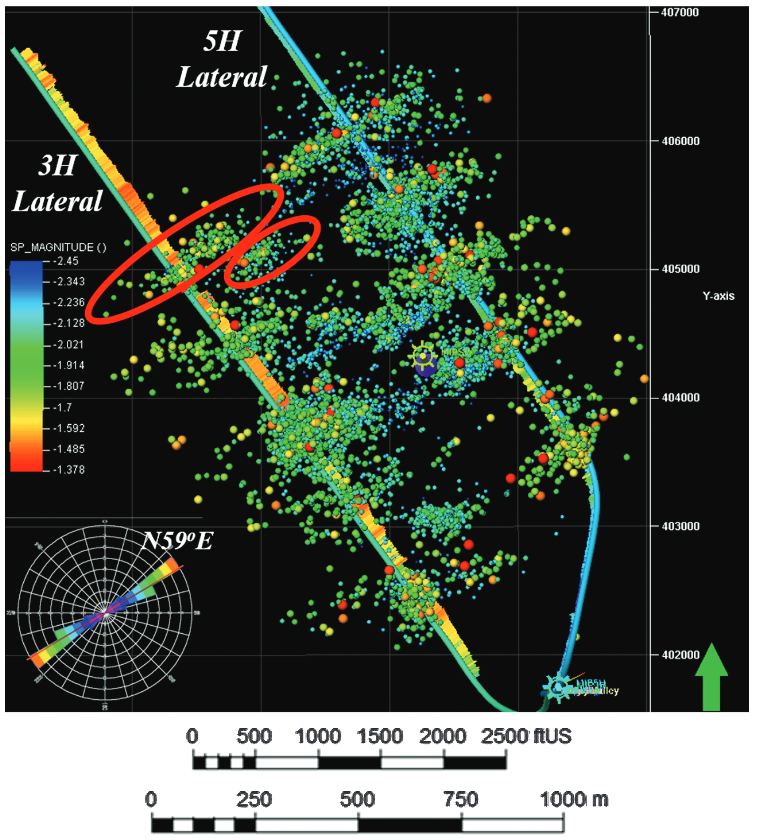 |
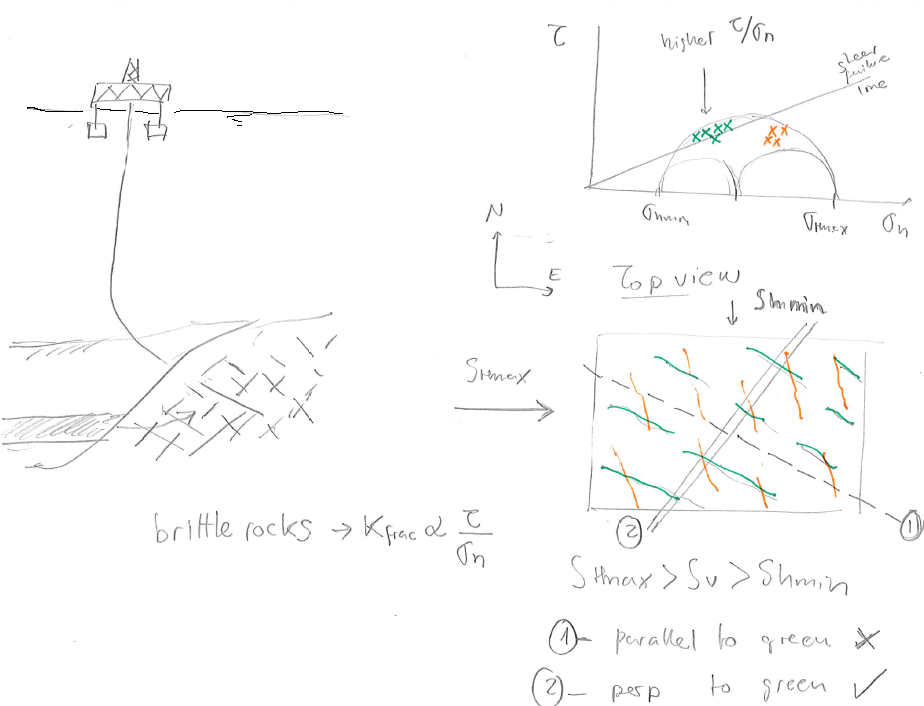 |
The same reasoning applies to large faults. There are faults that may be more easily reactivated due to pore pressure changes because of their orientation with respect to the current state of stress (See subsection 5.5.4).
Tectonic plates drive movements of the Earth's crust (Fig. 5.28). High temperatures and high effective stresses at great depth favor ductile deformation. Low temperatures and low effective stresses in the near-surface favor brittle failure.
![\includegraphics[scale=0.55]{.././Figures/split/6-21.pdf}](img830.svg) |
As a result of tectonic movement, there is ubiquitous shear failure and faulting of the Earth's shallow crust. The frictional strength of faults limits the maximum magnitude of stresses imparted by tectonic strains (Figure 5.29). Hence, horizontal stresses are proportional to tectonic strains in the elastic region, but their maximum value is limited by fault strength.
![\includegraphics[scale=0.75]{.././Figures/split/InSituStresses-ElastoPlastic.pdf}](img831.svg) |
Because faults are cohesion-less, the frictional strength equation is simply:
 |
(5.16) |
(like sand, zero-intercept in the y-axis) where 

![$q=[1+\sin(\varphi)]/[1-\sin(\varphi)]$](img832.svg)
The shear strength of the brittle crust has a direct implication in determining the maximum and minimum values of horizontal stresses for each stress regime once the tectonic strains are surpassed. Frictional equilibrium of the brittle crust implies that minimum and maximum attainable values of horizontal stresses are controlled by shear failure. Hence, for
 cannot be smaller than
cannot be smaller than
 , for
, for
 cannot be greater than
cannot be greater than
 , and for
, and for
 cannot be greater than
cannot be greater than
 .
.
As a result, the assumption of limit frictional equilibrium permits estimating minimum and maximum horizontal stresses if effective stresses


PROBLEM 5.13: A given site onshore is known to be subjected to a NF stress regime and hydrostatic pore pressure. Calculate the total horizontal minimum stress 

SOLUTION
The solution is a lower bound estimation of 
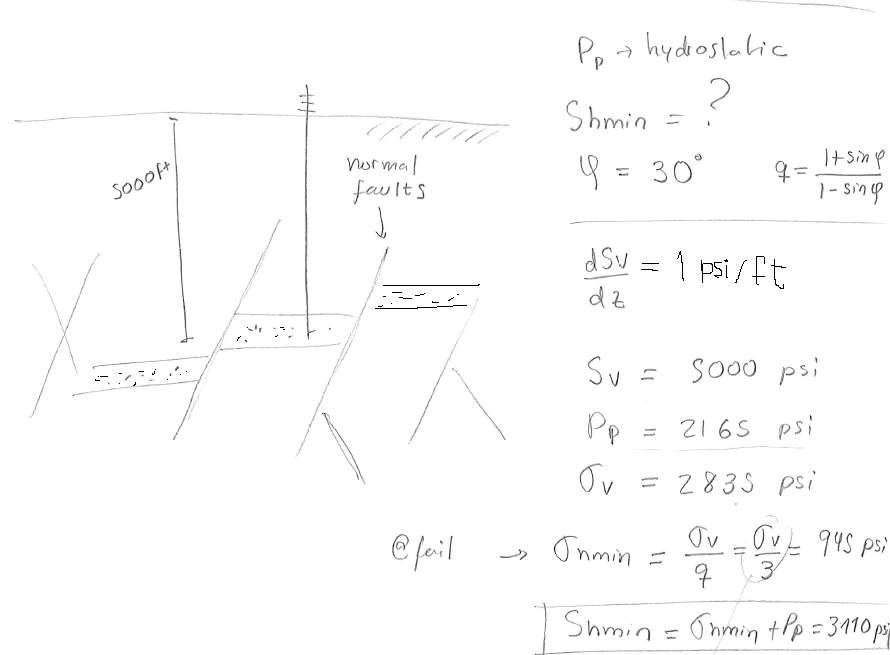

PROBLEM 5.14: A given site onshore is known to be subjected to a RF stress regime. Hard pressure is detected at 2,000 ft with



SOLUTION
The solution is an upper bound for 
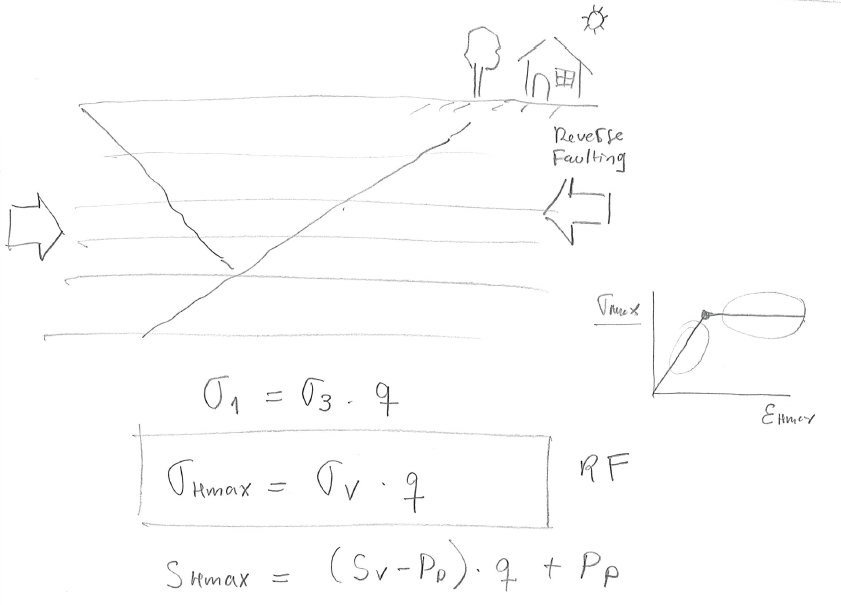
 psi/ft
psi/ft ft
ft psi
psi

 psi
psi psi
psi
and effective vertical stress is
 psi
psi psi
psi psi
psi
Finally, the maximum effective horizontal stress depends on the vertical effective stress (reverse faulting regime), so that
 psi
psi psi
psi
 psi
psi psi
psi psi
psi
The bounding limits of minimum and maximum horizontal stress for a given vertical stress and pore pressure can be plotted through Zoback's (effective) stress polygon (Fig. 5.30). The colored lines represent the bounds for normal faulting stress regime (NF), strike-slip faulting stress regime (SS), and reverse faulting stress regime (RF).
![\includegraphics[scale=0.50]{.././Figures/split/6-24.pdf}](img850.svg) |
For example, the state of stress for a place with a stress regime that fluctuates from NF to SS with depth would plot at the intersection of NF and SS lines in the stress polygon (Fig. 5.31).
![\includegraphics[scale=0.60]{.././Figures/split/6-25.pdf}](img851.svg) |
Mapping of faults and fractures in the subsurface helps interpret the state of stress that caused such fractures.
In some cases the state of stress that caused such faults may be still acting today.
The example in Fig. 5.32 shows an example of strike-slip conjugate faults.
The maximum horizontal stress that caused these shear faults was aligned with the bisectrix of the two fault strikes, about E10
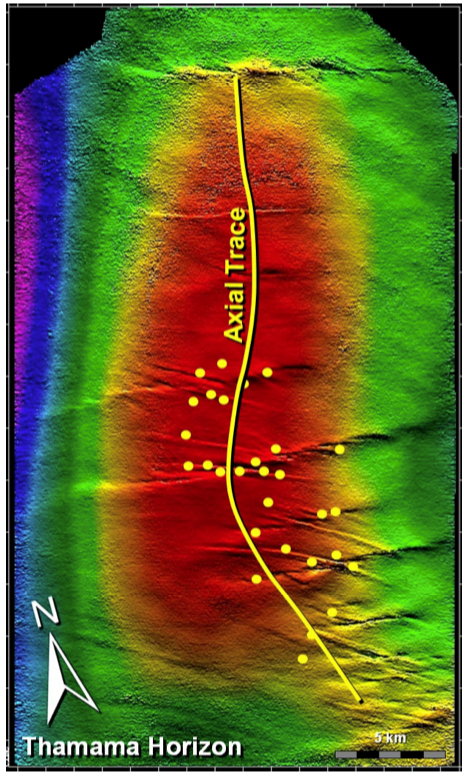 |
Depletion and injection of fluids in the subsurface cause changes in pore pressure and therefore on effective stresses.
Fluid injection such as in hydraulic fracturing, water-flooding, and waste-water disposal can reach adjacent faults (if any) and decrease the effective normal stress

![\includegraphics[scale=0.65]{.././Figures/split/6-FaultReactivation.pdf}](img852.svg) |
The change of stresses produced by increases of pore pressure assuming constant total vertical stress and negligible poroelastic effects is
 |
(5.17) |
The result is a shift of the Mohr circle to the left, closer to the shear failure or “reactivation” line.
The magnitude of change of pore pressure needed to reactivate a fault is (at least) equal to the horizontal distance between the point of the Mohr-circle of such fault and the failure line. Hence, a critically oriented fracture needs the lowest

The reactivation of faults may result in induced seismicity.
The imparted change of fault permeability depends on the fault filling, known as fault gouge.
Both, induced seismicity and change in fault permeability depend on the failure properties of the fault gouge.
Brittle failure results in high energy release through induced seismicity and increases of fault permeability, while ductile failure results in low energy release through seismicity and decreases or minor increases of permeability.
An undesired consequence of fault reactivation is the loss of hydrocarbon trapping ability at fault structural traps (e.g., https://www.youtube.com/watch?v=OtJTI4nv1QI).
Figure 5.34 shows an example of induced seismicity with magnitude 
![\includegraphics[scale=1.00]{.././Figures/split/DecaturCO2-MS.pdf}](img855.svg) |
 E, 45
E, 45 SE
SE
 S, 60
S, 60 NE
NE
 W, 25
W, 25 SW
SW
 W, 60
W, 60 NW
NW
 where
where  strikes E-W,
strikes E-W,  0.8, and
0.8, and  is a principal stress.
is a principal stress.
 where
where  strikes W20
strikes W20 N,
N,  , and
, and  is a principal stress..
is a principal stress..
![\includegraphics[scale=0.65]{.././Figures/split/StereonetProblem.pdf}](img860.svg)
 40 MPa,
40 MPa,
 MPa,
MPa,  MPa,
MPa,  MPa, and
MPa, and  acts E-W. For each of the faults below, calculate (using the 3D Mohr circle method if possible) the normal and shear stress on the plane of the fault and then determine if the fault is prone to slip assuming
acts E-W. For each of the faults below, calculate (using the 3D Mohr circle method if possible) the normal and shear stress on the plane of the fault and then determine if the fault is prone to slip assuming  .
.
 to the east
to the east
 to the north
to the north
 , dip 90
, dip 90
 , dip 25
, dip 25
 ,
,  ,
,  ,
,  ) on an arbitrary fault with orientation
) on an arbitrary fault with orientation
 for a given state of stress
for a given state of stress
 .
.
 creates an array
creates an array  (Nx1) of values in interval
(Nx1) of values in interval ![$[a,b]$](img868.svg)
 and
and  versus depth from 0 to 5 km assuming lithostatic gradient equal to 23 MPa/km, hydrostatic pore pressure equal to 10 MPa/km, and a state of stress limited by frictional strength of faults. Assume sliding friction coefficient is
versus depth from 0 to 5 km assuming lithostatic gradient equal to 23 MPa/km, hydrostatic pore pressure equal to 10 MPa/km, and a state of stress limited by frictional strength of faults. Assume sliding friction coefficient is  0.6. For both regimes, how does changing
0.6. For both regimes, how does changing  from 0.6 to 1.0 change the maximum possible differential stress
from 0.6 to 1.0 change the maximum possible differential stress  at a fixed depth of
at a fixed depth of  km?
km?
 0.78. Calculate the total minimum horizontal stress
0.78. Calculate the total minimum horizontal stress  at this depth (2,000 ft TVDSS) assuming frictional equilibrium of faults and friction angle 30
at this depth (2,000 ft TVDSS) assuming frictional equilibrium of faults and friction angle 30 . Draw the corresponding 2D Mohr circle with a solid line and draw an additional 2D Mohr circle with a dashed line assuming hydrostatic pressure. (Assume typical water and lithostatic gradients)
. Draw the corresponding 2D Mohr circle with a solid line and draw an additional 2D Mohr circle with a dashed line assuming hydrostatic pressure. (Assume typical water and lithostatic gradients)
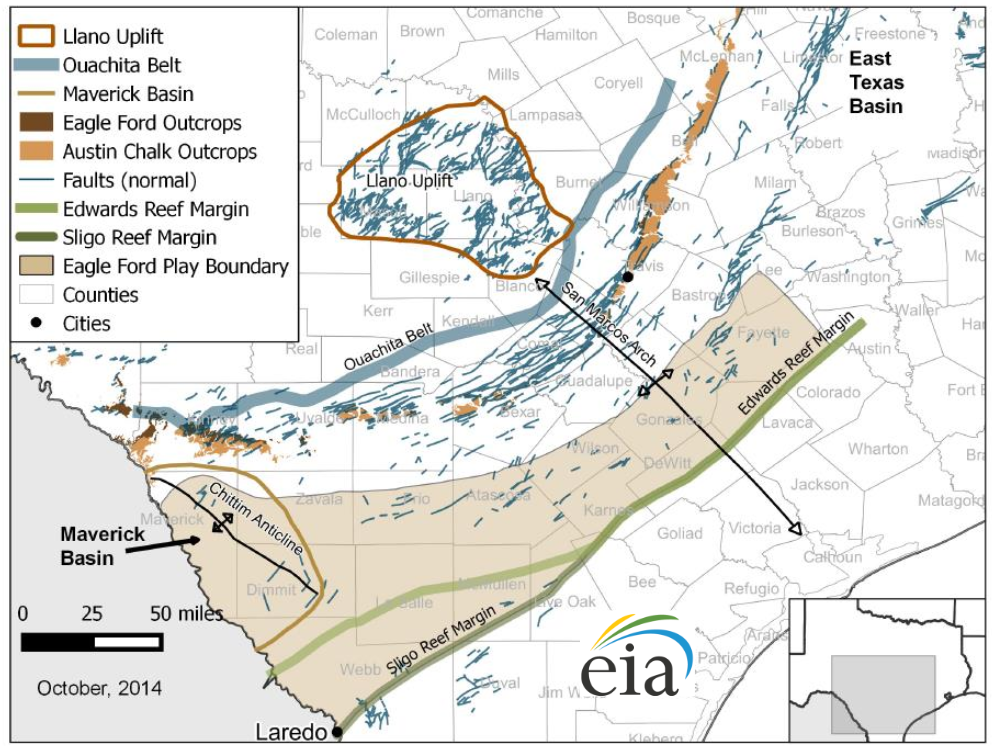
 in this area?
in this area?
 coincide with the direction expected from fault orientation? Justify.
coincide with the direction expected from fault orientation? Justify.